1.复习
2.生成器面试题
例子1:
def demo():
for i in range(4):
yield i
g=demo()
g1=(i for i in g)
g2=(i for i in g1)
print(list(g1))
print(list(g2))
执行结果:
[0, 1, 2, 3] []
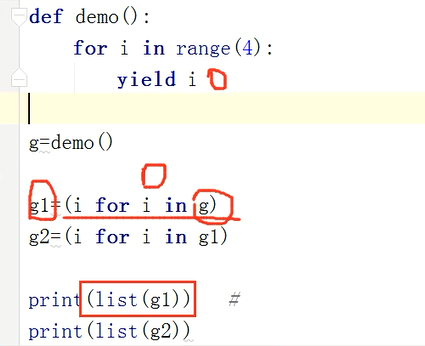
例子2:
def demo():
for i in range(4):
yield i
g=demo()
g1=(i for i in g)
g2=(i for i in g1)
print(list(g))
print(list(g1))
print(list(g2))
执行结果:
[0, 1, 2, 3] [] []
例子3:
def add(n,i):
return n+i
def test():
for i in range(4):
yield i
g=test()
for n in [1,10,5]:
g=(add(n,i) for i in g)
print(list(g))
执行结果:
[15, 16, 17, 18]
2.内置函数
http://www.cnblogs.com/Eva-J/articles/7206498.html#compile
接下来,我们就一起来看看python里的内置函数。截止到python版本3.6.2,现在python一共为我们提供了68个内置函数。它们就是python提供给你直接可以拿来使用的所有函数。这些函数有些我们已经用过了,有些我们还没用到过,还有一些是被封印了,必须等我们学了新知识才能解开封印的。那今天我们就一起来认识一下python的内置函数。这么多函数,我们该从何学起呢?
上面就是内置函数的表,68个函数都在这儿了。这个表的顺序是按照首字母的排列顺序来的,你会发现都混乱的堆在一起。比如,oct和bin和hex都是做进制换算的,但是却被写在了三个地方。。。这样非常不利于大家归纳和学习。那我把这些函数分成了6大类。你看下面这张图,你猜咱们今天会学哪几大类呀?
如图:
https://www.processon.com/view/link/597fcacfe4b08ea3e2454ece?pw=G76Z

那要学的一共4块,咱们从哪儿开始学起呢?
作用域相关
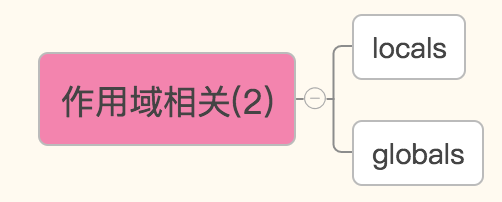
基于字典的形式获取局部变量和全局变量:
globals()——获取全局变量的字典
locals()——获取执行本方法所在命名空间内的局部变量的字典
迭代器/生成器相关
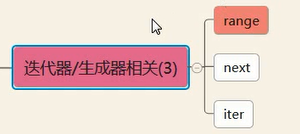
range是可迭代的不是迭代器。
其他
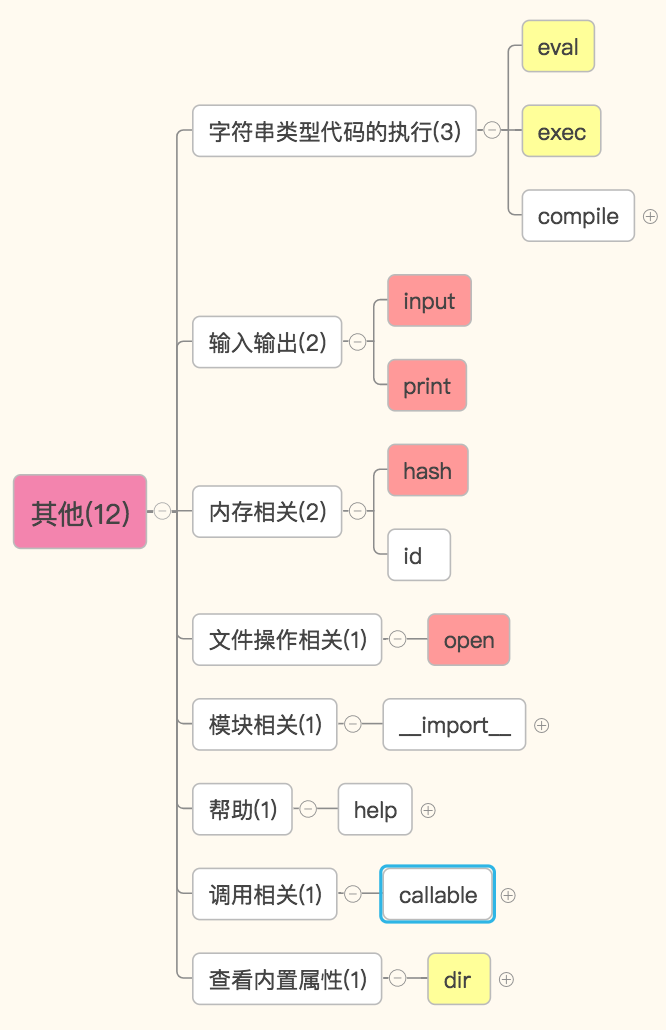
callable检测是不是一个函数
print(callable(print)) a = 1 print(callable(a)) print(callable(globals)) def func():pass print(callable(func))
help,查询的str所有的方法
help(str)
import
import time
# t = __import__('time')
# print(t.time())
# 某个方法属于某个数据类型的变量,就用.调用
# 如果某个方法不依赖于任何数据类型,就直接调用 —— 内置函数 和 自定义函数
file相关的操作,Open
f = open('1.复习.py')
print(f.writable())
print(f.readable())
id 内存地址,
hash
#hash - 对于相同可hash数据的hash值在一次程序的执行过程中总是不变的
# - 字典的寻址方式
# print(hash(12345))
# print(hash('hsgda不想你走,nklgkds'))
# print(hash(('1','aaa')))
# print(hash([]))#不可哈希的
input()
print()
print('我们的祖国是花园',end='') #指定输出的结束符
print('我们的祖国是花园',end='')
print(1,2,3,4,5,sep='|') #指定输出多个值之间的分隔符
f = open('file','w')
print('aaaa',file=f)# 打印到文件
f.close()
打印进度条:
import time
for i in range(0,101,2):
time.sleep(0.1)
char_num = i//2
per_str = '\r%s%% : %s\n' % (i, '*' * char_num) \ # \n是为了在for循环之后加print可以换行打印
if i == 100 else '\r%s%% : %s' % (i,'*'*char_num)
print(per_str,end='', flush=True)
princt输出:
def print(self, *args, sep=' ', end='\n', file=None): # known special case of print
"""
print(value, ..., sep=' ', end='\n', file=sys.stdout, flush=False)
file: 默认是输出到屏幕,如果设置为文件句柄,输出到文件
sep: 打印多个值之间的分隔符,默认为空格
end: 每一次打印的结尾,默认为换行符
flush: 立即把内容输出到流文件,不作缓存
"""
print源码剖析

f = open('tmp_file','w')
print(123,456,sep=',',file = f,flush=True)
exec('print(123)')
eval('print(123)')
print(eval('1+2+3+4')) # 有返回值
print(exec('1+2+3+4')) #没有返回值
# exec和eval都可以执行 字符串类型的代码
# eval有返回值 —— 有结果的简单计算
# exec没有返回值 —— 简单流程控制
# eval只能用在你明确知道你要执行的代码是什么,且用eval比较简单,不能为了简单不能忽略了安全,一般不要用。
compile 将字符串类型的代码编译。代码对象能够通过exec语句来执行或者eval()进行求值。
参数说明:
1. 参数source:字符串或者AST(Abstract Syntax Trees)对象。即需要动态执行的代码段。
2. 参数 filename:代码文件名称,如果不是从文件读取代码则传递一些可辨认的值。当传入了source参数时,filename参数传入空字符即可。
3. 参数model:指定编译代码的种类,可以指定为 ‘exec’,’eval’,’single’。当source中包含流程语句时,model应指定为‘exec’;当source中只包含一个简单的求值表达式,model应指定为‘eval’;当source中包含了交互式命令语句,model应指定为'single'。
#流程语句使用execcode1 = 'for i in range(0,10): print (i)'compile1 = compile(code1,'','exec')exec(compile1)
# 简单求值表达式用evalcode2 = '1 + 2 + 3 + 4'compile2 = compile(code2,'','eval')print(eval(compile2))
#交互语句用singlecode3 = 'name = input("please input your name:")'compile3 = compile(code3,'','single')exec(compile3) #执行时显示交互命令,提示输入
以后可以用name变量,比如print(name)可以打印出输入的内容
和数字相关:
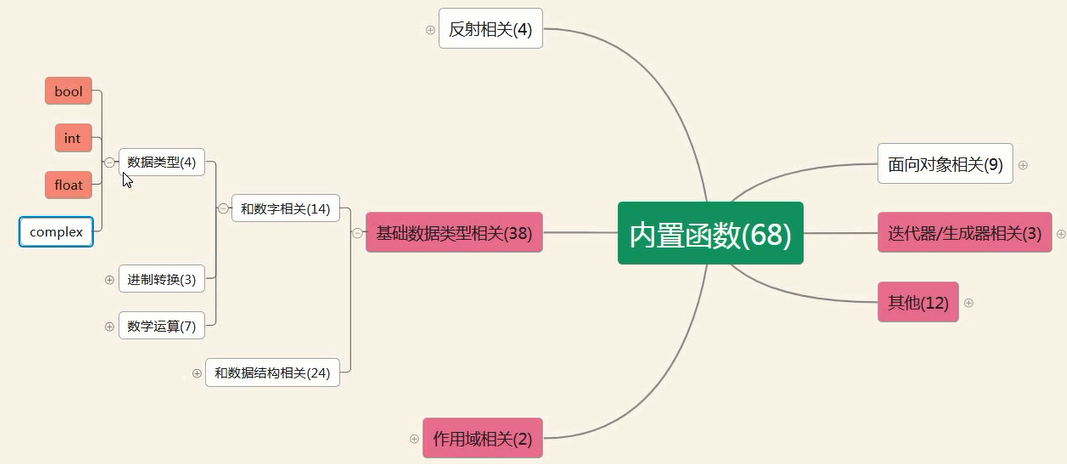
complex:基本上不用
复数———complex
实数———有理数:
无理数:无限不循环实数
虚数:虚无缥缈的数
浮点数(有限循环和无限循环小数) =!小数(有限循环和无限循环小数,无限不循环小数)
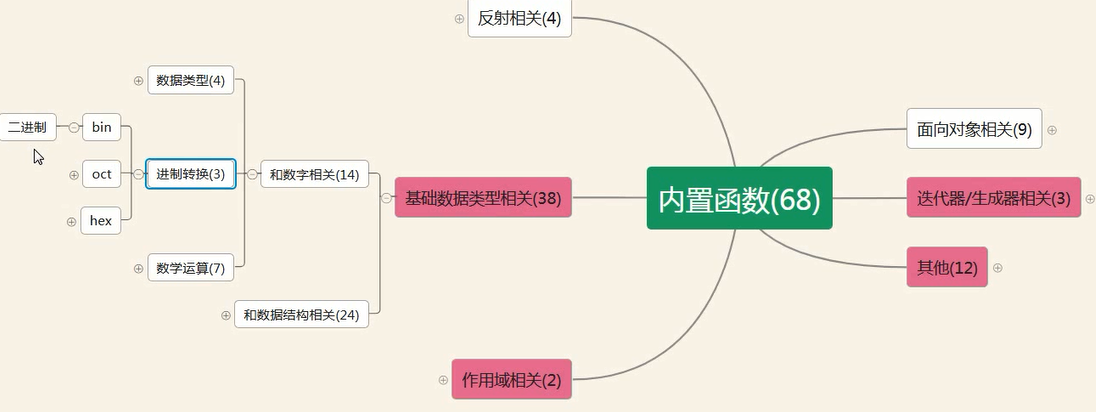
print(bin(10))#10进制转换成二进制 print(oct(10))#十进制转换成八进制 print(hex(10))#十进制转换成十六进制
执行结果:
0b1010 0o12 0xa
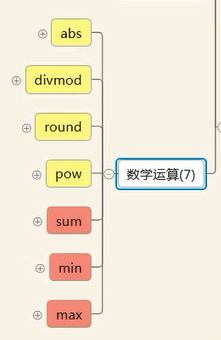
print(abs(-5))#绝对值 print(abs(5))#绝对值
print(divmod(7,2)) # div除法 mod取余 print(divmod(9,5)) # 除余#执行结果:
(3, 1)
(1, 4)
print(round(3.14159,3)) 执行结果,会四舍五入: 3.142
print(pow(2,3)) #pow幂运算 == 2**3 print(pow(3,2)) print(pow(2,3,3)) #幂运算之后再取余 print(pow(3,2,1)) 执行结果: 8 9 2 0
ret = sum([1,2,3,4,5,6],10)#start只能以位置传参 print(ret) 执行结果: 31 ret = sum([1,2,3,4,5,6]) print(ret) 执行结果: 21 sum(1,2) 执行结果:3
print(min([1,2,3,4])) print(min(1,2,3,4)) print(min(1,2,3,-4)) print(min(1,2,3,-4,key = abs)) 执行结果: 1 1 -4 1
print(max([1,2,3,4])) print(max(1,2,3,4)) print(max(1,2,3,-4)) print(max(1,2,3,-4,key = abs)) 执行结果: 4 4 3 -4
来源:https://www.cnblogs.com/liranranwangmeng/p/10081913.html
